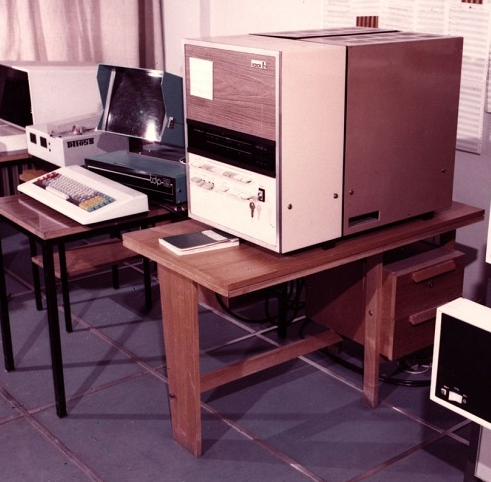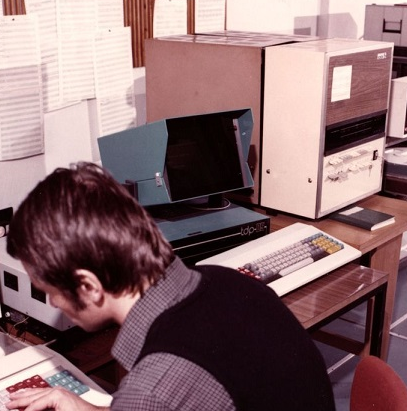The day I met my first computer.
I found a couple of pictures not so long ago and they reminded me of my first date with a real computer which happened on this day, February 15 of 1977… or maybe on another day, but around that time, the end of winter in 1977.
It was a long time ago and it is not true.
At the time I was studying Physics in the Moscow State University and was looking around for an opportunity to make a good project for my diploma, graduate with it (which is an equivalent of MS) and if I’m lucky find a job. Somebody… I know who that was but I stroke out his name from my memory and am not going to mension him here… brought me to the Plasma Physics Lab, because they needed a ‘student who can solder’ for an accelerator group that was working on something very important (ha-ha!). And that was me of course, because my then friend knew that I assemble my own ‘effects’ for the guitar performances that I was into then. In any case that was an interesting excursion into the world of Real Physics which proved to be amazingly not true much later, hehe.
At that time the Soviet Union was under all sorts of technological embargoes for its ‘good’ behavior in the Third World countries and we are not even talking about its own people. It manufactured a complete copy of IBM 360 line somewhere in the Eastern European countries and a more compact (wardrobe sized) computer “Мир” which means “Peace” in Russian - the name that would tell you that it’s, as always in the Bolshevik ‘newspeak’, something made for a purely military purpose. The Physics devision of the Moscow State University had a couple of those, they were breaking all the time and you had to get a time slot to run your program which students were not allowed to do unless they were doing it as a part of the course in programming (which was so idiotic that I didn’t understand anything from it, probably I was too stupid to understand what the idiot who ‘taught’ it was saying).
And there it was. The thing. The ‘computer’! It was in a CAMAC stand but approximately on the same level as in this picture. The “TPAi” (more about what it was - below), here it is:

As I said, the Soviet Union was under all sorts of sanctions and embargoes, but the ‘socialist countries’ of Eastern Europe - were not. Hungary in particular was enjoying a treatment almost as any other country and could buy all sorts of electronic components from the States. Their main Physics institute KFKi purchased a couple boatloads of components and put together around a thousand computers that they called TPA. The last letter stands for ‘analyser’, the rest - I don’t remember and I’m too lazy to google it now. Of course the “Hungarian Comrades” were not particularly conciencious, they stole and implemented the design of the best American mini-computer of the day - the PDP-8e, but… Oh, boy, the noise of these ventilators was awful. People in the big room where it stood could barely hear each other when I would fire up my ‘machine’. :) I don’t remember how many kilowatts it consumed, but the wires were really thick, I can tell you. And… it had two (that’s what the “i” stands for) ‘cubes’ (literally, cubes, I held them in my hand once) of memory 4k of 12 bit words each. Can you imagine? 4k words, where a full blown language FOCAL lived, where the programs for my CAMAC modules lived and even some data could live before I would dump it onto a paper punched through tape. All in 4k 12-bit words. For comparison, the graphical image of the cursor on your screen, probably, takes more memory. At that time the programmers were greedy. I remember there was a ‘Checkmate’ program that played chess (barely, but it didn’t make obvious mistakes) and it would fit in those 4k words too.
And of course the ‘socialist cooperation’ brought 3 or 4 of these computers to the main physics institute, I would call it a ‘flagman’ of the Soviet Science… ha-ha-ha! Right then around that very same time Physics in that country fell into a coma and stayed in this persistently vegitative state until its very timely death in the early nineties, but nobody told me then and it took me decades to find out what happened.

But I got a computer then! I played with it. I read the DEC books about it, I read the Donald Knuth’s books, I created my own programs… It was fun. :)
As I learned only a few years ago:
The PDP-8 was largely upward compatible with the PDP-5, a machine that was unveiled on August 11, 1963 at WESCON, and the inspiration for that machine came from two earlier machines, the LINC and the CDC 160. Both of these machines were characterized by a 12 bit word with little or no hardware byte structure, typically 4K words of memory, and simple but powerful instruction sets. The LINC was particularly important because it was built with DEC parts.
Although some people consider the CDC 160 the first minicomputer, the PDP-8 was the definitive minicomputer. By late 1973, the PDP-8 family was the best selling computer in the world, and it is likely that it was only displaced from this honor by the Apple II (which was displaced by the IBM PC). Most models of the PDP-8 set new records as the least expensive computer on the market at the time of their introduction. The PDP-8 has been described as the model-T of the computer industry because it was the first computer to be mass produced at a cost that just about anyone could afford. C. Gordon Bell has said that the basic ideas behind the PDP-5 and -8 were not really original with him. He gives credit to Seymour Cray (of CDC and later Cray) for the idea of a single-accumulator 12 bit minicomputer. Cray’s CDC 160 family (see CACM, march 1961, photo on page 244, text on page 246) was such a machine, and in addition to the hundreds of CDC 160 systems sold as stand-alone machines, a derivative 12 bit architecture was used for the I/O processors on Cray’s first great supercomputer, the CDC 6600.
Note that Cray’s 12 bit machines had 6 basic addressing modes with variable length instruction words and other features that were far from the simple elegance of the PDP-8. Despite its many modes, the CDC 160 architecture lacked the notion of current page addressing, it had no unconditional jump instruction, and the I/O instructions all blocked the CPU until I/O complete. As a result, the PDP-8 is both far more flexible and it supports much tighter programming styles.
Wesley Clark’s LINK architecture was particularly important because it was made from DEC modules, thereby demonstrating the price-performance point that a 12-bit machine could achieve using DEC’s technology. The operating system developed for the LINC, with its LINCtape-based file system and graphics display, makes it an excellent candidate for the honor of first personal computer or first workstation.
That’s why there were two ‘pages’ of memory (4k words each), Cray did it! :)